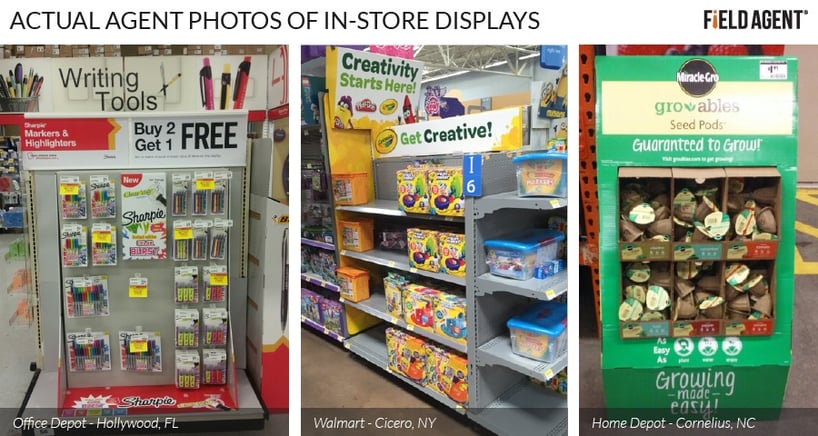
10 Reasons Your In-Store Product Displays Aren’t Converting Shoppers
![]() On the surface, an in-store display may seem like a pretty predictable thing: it’s set up; it’s stocked; and, voila, shoppers pick up your product.
On the surface, an in-store display may seem like a pretty predictable thing: it’s set up; it’s stocked; and, voila, shoppers pick up your product.
Simple, right?
But the typical retail operation is a swirling vortex of labor issues, managerial pressures, logistical complexities, seasonal obligations, dynamic pricing structures, information overloads/shortages, and an assortment of other factors that make display compliance much less certain. Much less.
Indeed, according to Retailing Today’s annual survey of the supplier community, “ensuring merchandise initiatives are executed at the store level” is the top challenge CPG companies face with retail partners, a difficulty encountered by 62% of survey respondents.
Sometimes it can be difficult to put your finger on one exact reason your displays aren’t being properly executed in stores and, thus, cashing in for your company. Display non-compliance often results from a complex combination of personnel, managerial, logistical, and informational factors.
But consider just 10 practical, “real world” reasons your in-store displays may not be selling more effectively:
10 Reasons Your In-Store Displays Aren't Converting Shoppers
1. Your point-of-sale materials never arrived at the store
Some displays are doomed from the start, because that fixture, rack, clip strip, sign, or other merchandising material never arrived at the store. It didn't even get its foot in the door.
Perhaps the display materials never left your company (you know how organizational communication is), or maybe a simple shipping error prevented them from arriving in-store?
See also: 7 Reasons Retail Shoppers Aren’t Buying Your Products
2. Your POS display materials arrived but the product didn’t
Naturally your POS materials need merchandise to showcase. But display effectiveness is partly dependent on supply chain efficiency—getting the right product to the right place at the right time in the right amounts.
And this opens the door to all kinds of scary what-ifs: What if, for example, the retailer’s inventory/execution management system reduces or cancels your shipment due to apparent high inventory levels? What if the store “turned off” all non-everyday product shipments?
3. Your display never made it to the store floor (it’s in the backroom)
In the merchandising game, it’s helpful to understand the tension between corporate execution plans and store-level realities. Local managers, contending with everything from surplus inventory to finicky local shoppers, may stray from corporate plans—including those delineating the details of your shopper marketing campaigns.
Your display, frankly, may be a low managerial priority at the store-level. Local management may want to push high inventory out the door, or they may be convinced another display will result in more sales.
4. Your display is “lost” in the store
It could be lost physically. By way of illustration, high inventory in or poor management of the backroom may block your display materials or product from employees’ view.
Download “How It Works: Mobile Audits” and take control of your display execution
5. Your display is a casualty of inaccurate information
Perhaps even more dangerous, your display could be virtually “lost.” The retailer's inventory management system, for one reason or another (e.g., human error), reflects that your display is in store and on the floor.
But the reality is: your display is MIA.

6. Your display is on the floor but in the wrong place
But even if your display makes it to the store floor, who’s to say it’s in the correct place? Many possibilities exist for why a display might end up in the wrong part of the store:
- Human error
- Space is at a premium, and store personnel plop displays wherever they can find space
- Local managers may feel other displays will sell better, and, thus, demote your display to a less visible corner of the store
- Stores may be eager to unload high or seasonal inventory, even if it means deviating from corporate’s plan
7. Your display is on the floor but stocked with the wrong product
Perish the thought, right? But it happens.
Maybe the display is stocked with the wrong version of your product? Or, worse—it’s almost hard to write—your display is stocked with competing and substitutable merchandise.
8. Your display is on the floor but paired with the wrong signage, video, or other aids
The display is largely there but the expensive bells and whistles are missing, leaving you and others wondering why sales are disappointing.
Yes, your product is on that powered endcap, but the digital TV display is missing or playing the wrong ad.
Yes, your four-way display is on the main aisle, but the visually alluring signage is collecting dust in the backroom.
9. Your display execution is a casualty of budget constraints
Often companies will fork out the funds for in-store displays and other POP materials, yet they don’t, won’t, or can’t budget for their effective execution.
As the problems above make clear, proper display execution is far from given. Consequently, shopper marketing campaigns should be monitored and controlled, which, of course, means proactively making room in the budget for such activities.
10. Your display execution lacks visibility
You can’t fix what you can’t see.
Consequently, the remedy for many of the problems above is pretty simple: greater in-store visibility.
Thanks to advancements in mobile technology and crowdsourcing, companies can now be with their displays wherever they are—and quickly spot problems with display compliance.
Mobile Audits offer a fast, affordable, and far-reaching way to take control of your display execution. Download the resource, “How It Works: Mobile Audits,” to see for yourself.

